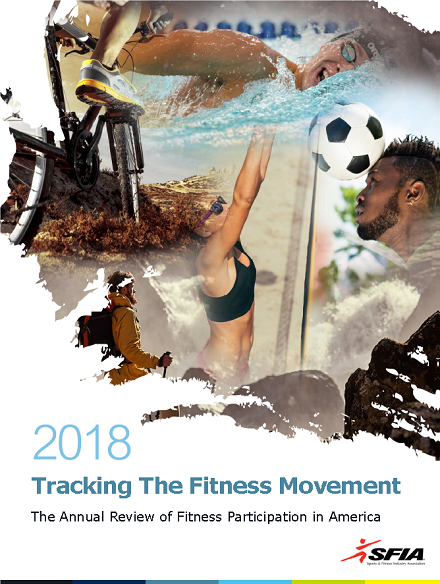
Want to know the future of sports events in America? Forget about looking into crystal ball, hosting a séance or even cracking open a fortune cookie. Two recent surveys show Americans are looking for experiences, not just fitness, and what’s more, they’re heading outdoors to get it.
The Sports and Fitness Industry Association (SFIA)’s report, “2018 Tracking the Fitness Movement,“ and the American College of Sports Medicine (ACSM) “Worldwide Survey of Fitness Trends for 2019” have come common denominators and those specific factors will be driving sports in the coming year. Savvy event owners who take advantage of those can reap the benefits.
SFIA, for example, noted that Americans are placing greater importance on creating communities for sports. This can include groups that run everything from 5Ks to marathons, pickleball leagues that enter tournaments together and cheer one another on and cycling clubs that enter gran fondos.
According to Sporting Goods Business, communities that help make fitness a lifestyle choice for consumers packs a wide array of benefits, including making individuals engage more and become more likely to become core participants, making them likely spend more money on related products, and be more vocal in endorsing the activity and products in word of mouth to others.
Also capitalizing on community engagement are many non-traditional venues such the Tough Mudder and Spartan Race events. Said SFIA president Tom Cove, “They’re all looking for quality too. They’re not looking to get some cheap machines that no one likes and they just sit there. So it’s all part of creating their community and making fitness a part of it.”
SFIA found the top 10 sport/fitness activities on a three-year average annual growth rate were bicycling (BMX), up 13.3 percent; cardio tennis, 11.3 percent; triathlon (non-traditional/off-road), 10.5 percent; skiing (freeski/freestyle) 9.7 percent; pickleball, 8.5 percent; rugby, 8.4 percent; hiking (day), 7.5 percent; trail running, 6.7 percent; cross training styles workouts, 6.6 percent; and stand up paddling 6.5 percent. Running – which has also cycled up and down in participation numbers over the years, has picked up in participation as well.
The fact that all of the above activities are outdoor sports – or mainly outdoor sports – is backed up by the ACSM, which notes that outdoor exercise and sports are in its top 20 trends. ACSM defines outdoor pursuits to include group walks, group rides or organized hiking groups. They can be short events, daylong events, or planned week hiking excursions. Participants may meet in a local park, hiking area, or on a bike trail with a leader. The trend for health and fitness professionals to offer outdoor activities for their clients began in 2010.
Fitness Wearables
At ACSM, wearable technology took over the #1 spot for 2019 after dropping to #3 in 2018, which may be the result of manufacturers correcting some monitoring inaccuracies of the past. Wearable technology has also been credited with the rise in the number of individuals being able to participate in events such as virtual marathons (run either on a treadmill or in person) and virtual triathlons. Even the TCS New York City Marathon is offering a virtual option.
Demographic Shifts
Athlete participation can be stratified by age. SFIA noted that millennials were driving shifts in the sports market by sampling a variety of workouts; they might run, do yoga, go hiking and play, making them different from their other generational peers who tend to find one form of exercise and stay with it.
As an example, Cove said, “People in the running business have said, “My customers have changed from a person who says, ‘I am a runner’ to a person who says, ‘I run and I do a bunch of other things,’” which may include other activities that feature running.
ACSM also listed exercise for older Americans as a strong trend. Propelled by masters’ programs, Senior Games, senior softball and other versions of sports offered to athletes who are, for lack of better term, grown-ups, individuals are thriving in their ability to compete (or continue competing) – with many of those being the women who were denied the ability to compete in sports prior to the advent of Title IX.
The highest percentage of baby boomers (defined as ages 52-71) listed walking for fitness as their favorite activity, followed by treadmill, weights and stationary bikes. (However, it should be noted that walking was also tops for Gens X and Y, and was second-most-favorite for Gen Z.) And because walking is one of the aforementioned experiential sports, allowing participants to enjoy their surroundings, friends and more, it dovetails with the findings.
Various Trends Worth Noting
ACSM noted that high-Intensity Interval Training (HIIT), the #1 trend in 2014 and 2018, fell to #3 for 2019. Group training made a significant return in 2017 as the #6 trend and has been the #2 trend for the past 2 years (2018 and 2019). Fitness programming aimed at older adults has regained some popularity after falling out of the top 10 trends in 2017, appearing at #9 in 2018 and now #4 for 2019.
Bodyweight training first appeared as a fitness trend at #3 in 2013 and has been a top five fitness trend since that time, realizing a peak as the #1 fitness trend in 2015. In 2019, bodyweight training is the #5 fitness trend. A new trend to watch will be the employment of certified fitness professionals, a new potential trend for 2019 (#6) replacing educated, certified, and experienced fitness professionals, which was determined to be too broadly defined for this survey.
Other trends to watch are mobile exercise apps, worksite health promotion and workplace well-being programs, outcome measurements, and post-rehabilitation classes (something important to athletes of all ages but may be particularly important if studied in conjunction with athletes in the senior categories in years to come).
The ACSM report is available through this link. The SFIA report is available through this link.

